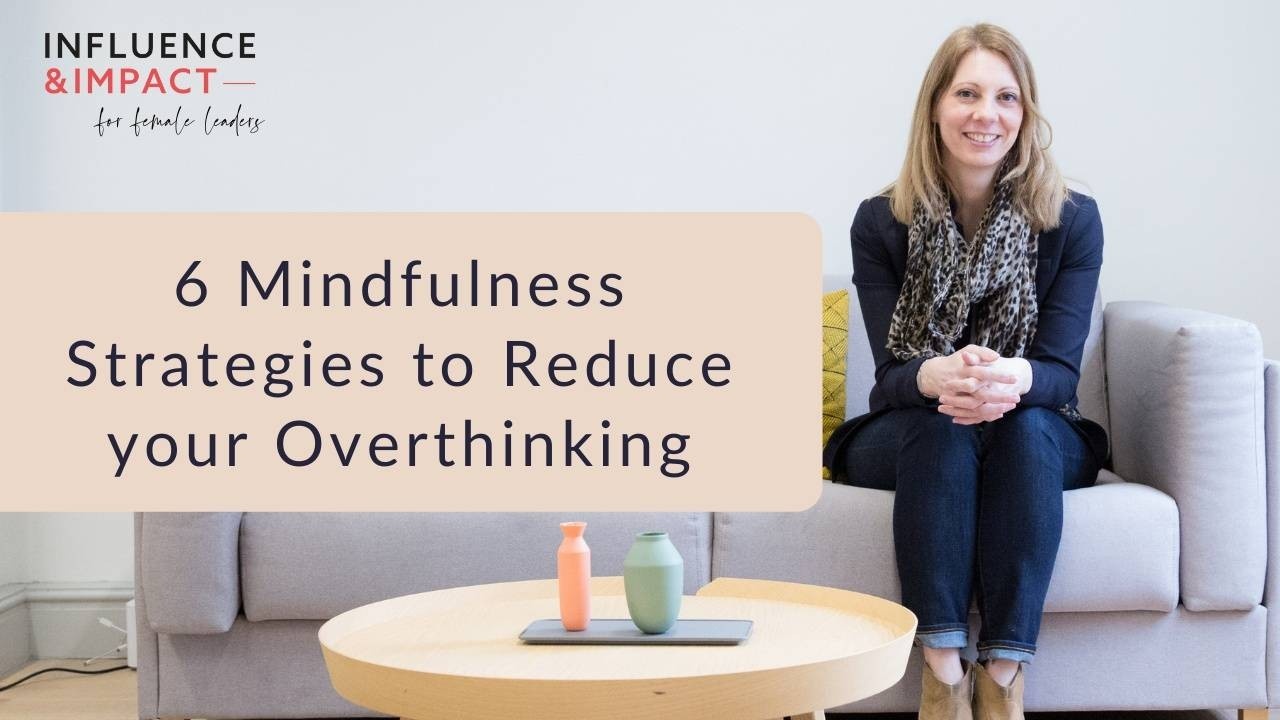6 Mindfulness Strategies to Reduce your Overthinking

Are you the boss of your brain or is your brain the boss of you?
Overthinking is something your mind will naturally do.
You might ruminate on past situations, worry about future events or are fearful of the judgement of others.
All of this overthinking can stop you from enjoying the present moment plus creates stress, anxiety and affects your self-confidence.
The good news is, everyone has the ability to train their mind, change their thinking habits and be the boss of their brain.
In the latest episode of the Influence & Impact for Female Leaders podcast, I interview Tahirih Mclaren-Brown, a mindfulness coach who helps to free people from overthinking, anxiety, worry and fear.
Tahirih shared 6 mindfulness strategies you can use to reduce your overthinking and build a calmer, more confident mind.
- The Awareness Diary
- Thoughts, Emotions, Questions
- Sitting in Discomfort
- Embracing Uncertainty
- Meditation
- The Four Step Pause
The Awareness Diary
It’s important to start by bringing awareness to the types of thoughts you’re having, what emotions they trigger for you and how they physically feel in your body. This way you can quickly recognise when your overthinking is causing you stress and anxiety and focus on easing it.
For a week, take note of whenever you start overthinking and write down:
- What thoughts you’re having
- What emotions you’re feeling
- How these emotions feel physically in your body
Thoughts, Emotions, Questions
All of your emotions start with your thoughts. You don’t feel anything unless you first think it.
When you’re feeling an unpleasant emotion, ask yourself what thoughts you’re having to create that emotion. Once you’ve identified those thoughts ask yourself some simple questions such as:
“Why am I thinking these thoughts? What fear in underneath them?”
“Are these thoughts that truth? Do I need to believe them?”
“If I had the choice, what thoughts would I choose instead of these ones?”
Sitting in Discomfort
Your thoughts and emotions cannot harm you. Although we naturally try to avoid unpleasant emotions, they only cause a feeling of discomfort. If you are willing to sit in the discomfort instead of avoiding, distracting or pushing them away, you’ll be able to understand why you’re feeling that way and move through it.
You could start by setting a timer for 5 minutes and letting yourself sit with whatever thoughts and emotions you’re experiencing.
Embracing Uncertainty
The human brain naturally tries to avoid uncertainty. Your reptilian brain sees uncertainty as possible danger which is why you might feel uncomfortable and unsettled when something in your future is uncertain.
We can reframe uncertainty and stop labelling it as a negative thing. An uncertain future also holds the possibility of wonderful opportunities, people and experiences. Our brain also naturally underestimates your capabilities and resources.
When you’re feeling uncertain, remind yourself that uncertainty isn’t a bad thing and you are an adaptable person who embraces new opportunities and challenges.
Meditation
Meditation is one of the key practices in mindfulness and it’s one of the most important tools you have for training your brain (or taking it to puppy school).
Meditation allows you to observe your thoughts and emotions and choose what thoughts you want to pay attention to, and which ones you want to let go of.
A meditation practice trains you how to focus, how to sit in discomfort and how to accept what is out of your control.
Meditation can be challenging for overthinkers but see it as an essential skill that gets easier with practice. Try one of the many apps to help you get started.
The Four Step Pause
Tahirih shared a simple exercise called the Four Step Pause which can instantly ease your overthinking and stress. When you are feeling overwhelmed with your thoughts and have recognised your emotional response, try this. You can do it anywhere in a couple of minutes. If you’re in a space you feel comfortable, you can close your eyes.
Step 1:
Listen to all the sounds around you. Try to pay attention to each individual sound and let them come and go from your awareness.
Step 2:
Notice your body and all the points of contact it has. Perhaps you can feel your feet on the floor, your hands resting on your lap or the weight of your body pressing down on the seat beneath you.
Step 3:
Take some deep breaths into your belly. This is the best way to calm your body down, tell it that you’re safe and create some space in your mind to think clearly. It can help to count your breaths and take as many as you need until you feel your body relaxing.
Step 4:
Ask yourself “What do I need to do next to look after myself?”. It could be recognising that you need go outside for a walk, take a break, drink some water or have a snack, journal how you’re feeling or even just rewrite your to do list so it’s not so overwhelming.
Each of these mindfulness strategies can be practiced daily to help you to ease your overthinking and learn to control your thoughts and emotions.
You are not stuck as an overthinker.
It is simply a habit that you’re able to change.
Over time, you can train your mind and become the boss of your brain.
You can listen to the full podcast interview with Tahirih here: https://www.carlamillertraining.com/podcast
Listen to the Influence & Impact podcast on Carla’s website, Apple, Spotify or Stitcher
For more articles on the issues that impact women leaders at work follow Carla Miller on LinkedIn
Find out about the various ways Carla works with women leaders and organisations on her website www.carlamillertraining.com

